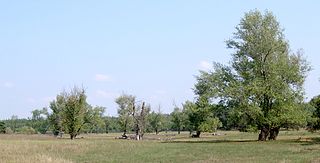
Populus nigra, the black poplar, is a species of cottonwood poplar, the type species of section Aigeiros of the genus Populus, native to Europe, southwest and central Asia, and northwest Africa.

Populus tremuloides is a deciduous tree native to cooler areas of North America, one of several species referred to by the common name aspen. It is commonly called quaking aspen, trembling aspen, American aspen, mountain or golden aspen, trembling poplar, white poplar, and popple, as well as others. The trees have tall trunks, up to 25 metres tall, with smooth pale bark, scarred with black. The glossy green leaves, dull beneath, become golden to yellow, rarely red, in autumn. The species often propagates through its roots to form large clonal groves originating from a shared root system. These roots are not rhizomes, as new growth develops from adventitious buds on the parent root system.
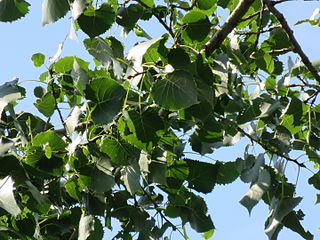
Populus deltoides, the eastern cottonwood or necklace poplar, is a species of cottonwood poplar native to North America, growing throughout the eastern, central, and southwestern United States as well as the southern Canadian prairies, the southernmost part of eastern Canada, and northeastern Mexico.

Populus fremontii, commonly known as Frémont's cottonwood, is a cottonwood native to riparian zones of the Southwestern United States and northern through central Mexico. It is one of three species in Populus sect. Aigeiros. The tree was named after 19th-century American explorer and pathfinder John C. Frémont.

Saperda is a genus of flat-faced longhorn beetles belonging to the family Cerambycidae, subfamily Lamiinae. The genus was erected by Johan Christian Fabricius in 1775.

Populus × canescens, the grey poplar, is a hybrid between Populus alba and P. tremula. It is intermediate between its parents, with a thin grey downy coating on the leaves, which are much less deeply lobed than the leaves of P. alba. It is a very vigorous tree with marked hybrid vigour, reaching 40 metres tall and with a trunk diameter over 1.5
Conizonia guerinii is a species of beetle in the family Cerambycidae. It was described by Breme in 1840, originally under the genus Saperda. It is known from Tunisia and Algeria.

Menesia bipunctata is a species of beetle in the family Cerambycidae. It was described by Zoubkov in 1829, originally under the genus Saperda. It has a wide distribution in Europe and Asia. It measures between 6 and 9 mm. It feeds on Juglans regia and Frangula alnus.
Nupserha bidentata is a species of beetle in the family Cerambycidae. It was described by Johan Christian Fabricius in 1792, originally under the genus Saperda.
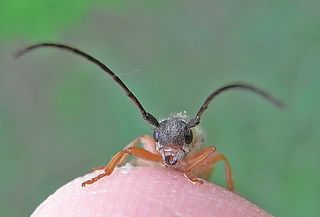
Oberea euphorbiae is a species of beetle in the family Cerambycidae. It was described by Ernst Friedrich Germar in 1813 originally under the genus Saperda. It has a wide distribution in Europe. It feeds on Euphorbia palustris.

Phytoecia nigricornis is a species of beetle in the family Cerambycidae. It was described by Johan Christian Fabricius in 1781, originally under the genus Saperda. It has a wide distribution throughout Europe. It measures between 8 and 13 mm. It feeds on Glebionis segetum, Solidago virgaurea, Artemisia campestris, Artemisia absinthium, Artemisia vulgaris, Artemisia sieversiana, Leucanthemum vulgare, and Tanacetum vulgare.

Saperda calcarata, the poplar borer, is a species of beetle in the family Cerambycidae. It was described by Thomas Say in 1824. It is known from Canada and the United States. It contains the varietas Saperda calcarata var. adspersa.
Saperda inornata is a species of beetle in the family Cerambycidae. It was described by Thomas Say in 1824. It is known from Canada and the United States. It feeds on Populus tremuloides.

Saperda candida, the roundheaded appletree borer, is a species of beetle in the family Cerambycidae. It was described by Johan Christian Fabricius in 1787. It is known from Canada and the United States. It contains the varietas Saperda candida var. bipunctata.
Saperda fayi is a species of beetle in the family Cerambycidae. It was described by Bland in 1863. It is known from Canada and the United States.
Saperda interrupta is a species of beetle in the family Cerambycidae. It was described by Gebler in 1825. It is known from China, Russia, Siberia, Korea and Japan. It is associated with coniferous plantations, and infests species of fir, pine, spruce and other conifers.
Saperda lateralis is a species of beetle in the family Cerambycidae. It was described by Johan Christian Fabricius in 1775. It is known from Canada and the United States.
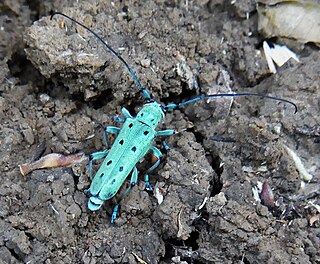
Saperda octopunctata is a species of beetle in the family Cerambycidae, and the type species of its genus. It was described by Scopoli in 1772, originally under the genus Leptura. It has a wide distribution in Europe. It feeds on Populus tremula.
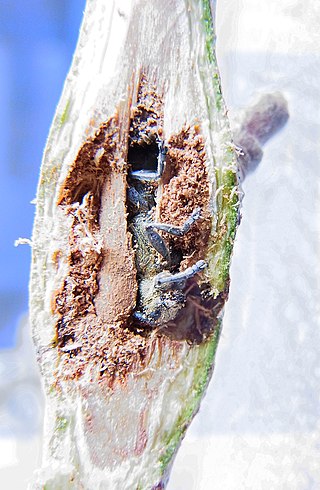
Saperda populnea, the small poplar borer, is a species of beetle in the family Cerambycidae which forms woody galls on twigs of poplars and willows. It was described by Carl Linnaeus in 1758.
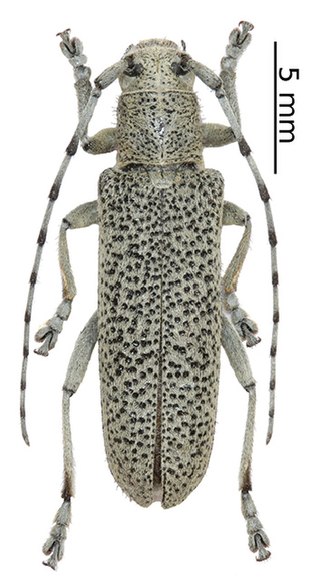
Saperda similis is a species of beetle in the family Cerambycidae. It was described by Laicharting in 1784. It has a wide distribution in Europe. It feeds on Salix caprea. It contains the varietas Saperda similis var. albopubescens.














